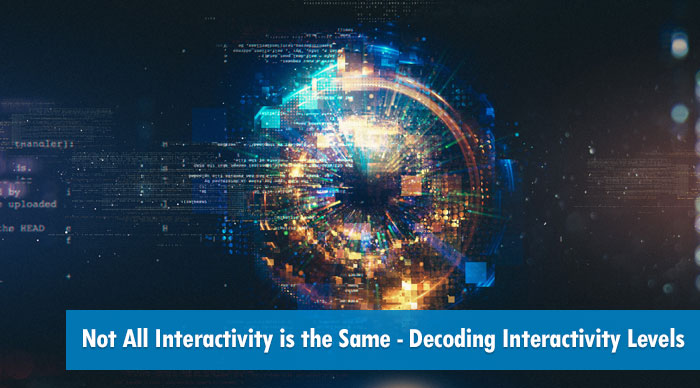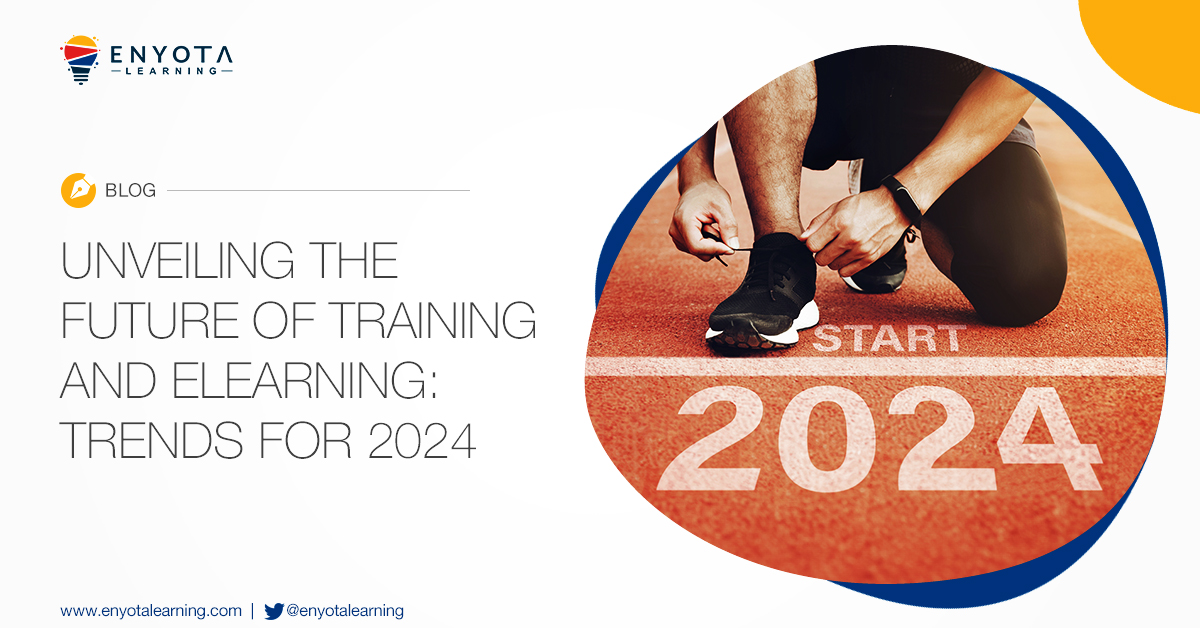Why Use eLearning Interactivity?
Using interactive elements in eLearning can significantly enhance the learning experience and promote better retention of the subject matter. From simple click-to-reveal actions to immersive simulations and gamification, eLearning interactivity levels can be tailored to meet the specific requirements of the content design, audience’s needs, and budgets. Interactivity in eLearning can extend from simple click-to-reveal kind of actions to reproducing situations and scenarios with multiple-choice options.
With the use of interactive elements such as drop-down, click-to-reveal, and others, learners can interact with the training and thereby be more engaged by the training experience.
However, it’s essential to determine the appropriate interactivity level by considering various factors, including technological limitations, desired outcomes, and learning complexity, and budgets.
Interactivity in eLearning is broken down into the following levels:
Level 1 – Low-Level Interactivity/Page Turners
Level 1 of eLearning interactivity, also known as “Page Turners,” is the most basic level of interactivity in eLearning design. At this level, the focus is on delivering content in a structured and organized way, breaking it down into smaller, bite-sized pieces to make it easier for learners to comprehend. The media used at this level is quite simple, such as photographs and icons, which may or may not be accompanied by audio or video.
Learners have minimal control over the learning environment at this level, and the level of interaction is passive. The content is presented to them in a linear way, with no branching or decision-making involved. However, basic assessments may be included at the end of each section to ensure that learners have understood the material.
This level of interactivity can be useful in situations where the primary goal is to build awareness or provide learners with basic procedural information. For example, a company may use this level of interactivity to train its employees on the proper use of equipment or software. This level can also be effective when a “show me how to” kind of presentation is needed, such as when demonstrating a new product or service to potential customers.
While Level 1 interactivity may be basic, it still offers advantages over traditional methods of training, such as PowerPoint presentations. By breaking down content into smaller, more manageable pieces and including basic assessments, learners are more likely to retain information and stay engaged with the material.
Level 2- Medium to High Interactivity (Audio-Driven)
Level 2 of eLearning interactivity is a more dynamic approach to delivering eLearning, as learners are allowed more control and engagement with the learning material. It employs animations, graphics, and interactive elements such as clickable tabs, icons, infographics, and roll-overs to keep learners engaged. This level also includes audio and video elements like introductory videos and product demonstrations to improve learning outcomes.
Unlike Level 1, the emphasis here is on application objectives, where learners must demonstrate the knowledge they’ve acquired from the content. This level is more audio-driven, where learners do more than just watch, read or navigate the learning material. They engage with learning conditions through interactive assets such as movement, sight, and sound.
Navigation in this level expands to glossaries and links to external resources, with exercises such as quizzes, identification components, drag and drop, matching, etc. This level is ideal for eLearning situations focused on on-the-job-performance improvements, process and product training, and skill development, rather than just knowledge transfer.
Level 2’s more media and audio-driven approach helps to prevent content overload, allowing learners to take in information in manageable, digestible chunks, at their own pace. This level of interactivity is an excellent way to ensure learners remain actively engaged, leading to better retention and application of learning outcomes. Therefore, understanding and utilizing Level 2 interactivity in learning experience design can result in more effective eLearning programs that achieve desired outcomes.
Level 3 – Medium to High Interaction Using Conversation/ Stories/ Games/ Branching, etc.
Higher interactivity levels in eLearning are best suited for courses with a moderately high degree of complexity, demanding active learning due to multiple inter-related concepts and multidimensional problems that require authentic representation and advanced practice. Graphics, animations, and gamified quizzes are employed, and the learner has a higher degree of control over the course environment.
The content is presented in the context of real business problems and employs audio, videos, and simulated environments with interactivity appearing more regularly, say on every 3rd screen. This level also employs more complex and narrated animations and has a flexible or customized navigation structure.
This method is best suited for training on problem-solving capabilities such as financial calculations, menu-driven applications, or new software environments. This learning method provides a ‘safe’ environment for learners to learn the impact of their decisions in a simulated environment. The emphasis is on application, knowledge transfer, and retention, and the learner must make complex decisions. Immediate remediation is provided in case of poor performance.
Overall, higher interactivity levels are great for courses requiring active learning, skill development, and performance improvements. These courses emphasize application and retention, providing learners with a safe environment to make complex decisions.
Level 4 – Advanced Interactivity (Videos/explainers)
This level employs a high level of instructional and visual design, using an animated explainer or video-type approach. Simulations, high-impact graphics, complex animations, highly recharged interactivities, self-checks and practice sessions with a higher degree of sophistication. This level employs a story line with characters and may also have interactive elements.
The creation of personalized or dynamic environments using real-life scenarios and digital avatars to teach complex theories or concepts with a professional run-through enable better comprehension and deliver a better learning impact. This approach works great for presenting how-to videos, product demonstrations, change management, story-telling, etc.
This level of eLearning is a good learning option when the objective of the course is to help learners understand complex and multifaceted business problems or teach them high-level or advanced decision-making skills, or even to bring about in change in attitude and behavior. Live recordings of customer interactions, for example, can be used to training customer-facing teams where they get to see an actual or simulated interaction, thus helping them up their skills in a faster more relatable set-up.
Level 1 and Level 2 interactivity is well suited for training that needs frequent updating such as new hire orientations or company policies. It is also great for larger training programs where budgets might also be a constraint.
It is to help learners understand complex and multifaceted business problems or teach them high-level or advanced decision-making skills, or even to bring about a change in attitude and behavior. Live recordings of customer interactions, for example, can be used to training customer-facing teams where they get to see an actual or simulated interaction, thus helping them up their skills in a faster more relatable set-up.
Level 3 and 4 are ideal for situations where the learners need to be motivated to take the course, if they need to improve productivity, and where their actions have a direct business impact. Evaluating the technical environment such as bandwidth, software etc. is essential for employing Level 3 and 4 interactivities.
When it comes to interactivity, sometimes less can be more and vice versa. The learning objectives and the desired outcomes must drive the level of interactivity your course needs. Consider your learner personas, their level of comfort with online training, their job requirements, and of course, your budgets and business needs, before applying a certain instructional and visual design strategy. Consult a Learning Solutions Specialist to help you define what is the best approach you need to take.
At eNyota we strive to deliver the best experience your learners can get. Our interactive courses are based on the levels mentioned above and are designed and created to provide an optimal level of learner engagement and completion rates. If you’re interested in knowing more about the next course you want to build and how it can be achieved, reach out to us by filling a contact form and one of our representatives will reach out to you. Try our learning management system – Abara LMS here.





